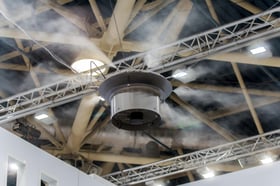Humidification Systems

Humidification systems tend to get less attention than space heating and air conditioning. However, human comfort not only depends on temperature, but also on air humidity.
The American Society of Heating, Refrigerating and Air-Conditioning Engineers (ASHRAE) recommends that relative humidity (RH) be kept between 30% and 60% to provide a comfortable and healthy environment for occupants. Professional MEP engineers can design humidification systems that keep indoor air within the recommended RH range.
Outdoor air tends to have the lowest humidity during winter, and it becomes even drier as it passes through space heating systems. As a result, indoor air can easily reach a relative humidity value below the 30% recommendation from ASHRAE. Excessive dryness is detrimental for human health and comfort, while damaging wood and paint. Dry air also has a negative effect on quality in some industrial processes, and it increases the chance of damaging electronic equipment with an electrostatic discharge.
Since humidification systems consume electricity, energy efficiency is an important consideration during the design process. By working with qualified HVAC engineers, you can ensure your humidification system is properly sized and configured to only operate when needed. There is no need to waste energy on humidification when the air is already within the recommended range.
How Do Humidification Systems Work?
Although humidification systems have a common purpose, they differ in the method used to achieve it. The following are the most common types of humidification systems:
- Steam humidifiers increase indoor air humidity with a controlled dispersion of steam, often with the assistance of ventilation systems. Steam-based humidification is the most expensive method but also the cleanest, and for this reason it is preferred in healthcare applications.
- Atomizing humidifiers spray water at high pressure to increase indoor air humidity, and they have the lowest operating cost among humidification systems. Atomizing humidifiers are also characterized by their flexible design, and adaptability to serve a wide variety of humidification loads.
- Ultrasonic humidifiers produce a cool mist to humidify indoor spaces. They are less efficient than atomizing humidifiers, but still much more efficient than steam humidifiers. The mist produced by ultrasonic humidifiers is quickly absorbed into the air, preventing the accumulation of droplets on surfaces.
Humidification is measured in kilograms per hour (kg/h). A steam humidifier consumes around 750 watts per kg/h, an ultrasonic humidifier consumes around 50 watts per kg/h, and an atomizing humidifier consumes around 5 watts per kg/h.
Humidification Systems Make Indoor Spaces Healthier
Low air humidity causes discomfort for humans, and it can also lead to several health issues. When a building has problems with dry air, one of the first symptoms experienced by occupants is eye and skin irritation. Excessive dryness can also irritate the respiratory system, and it can cause asthma flare-ups in persons suffering from the condition.
Excessive dryness also causes particles to stay suspended in the air longer, and this has several negative consequences:
- Viruses spread more easily when the air is dry, and this includes cold and flu, which are common illnesses during winter.
- Dust particles and other air pollutants also stay airborne longer when air humidity is low, and they can cause allergic reactions in sensitive individuals.
Humidification systems greatly reduce the issues above, making indoor environments more comfortable and healthy. However, you must make sure that relative humidity is not increased beyond 60%, since a high moisture content in the air leads to other issues. For example, high humidity stimulates the growth of bacteria, mold and dust mites.
Humidity control is important in all indoor environments, but some applications have extremely demanding requirements. For example, dry air is unacceptable in hospitals because it exposes patients to viruses and airborne dust, while irritating their respiratory system.
Humidification Systems Prevent Building Damage
Some construction materials are susceptible to low humidity conditions, and you may start seeing damage on some surfaces and furniture if your indoor air is too dry. In other words, dry air causes expenses because some building elements must be repaired eventually.
- Wooden floors, surfaces and furniture are prone to deformation and cracking under extreme dryness.
- Paint and plaster may crack and fall off when indoor air is too dry.
A humidification system of the right capacity can help extend the service life of expensive construction materials and furniture. Just like with health and comfort, the ideal humidity range recommended by ASHRAE applies here; excessive humidity leads to mold growth, which damages many surfaces and materials.
Humidification Systems Protect Sensitive Electronic Equipment
You have surely experienced electrostatic discharges during winter, especially when touching metallic objects like doorknobs and kitchenware. This happens because electric charge accumulates on objects more easily when the air is dry.
Electrostatic discharges can be scary and slightly painful, but they are not a threat for humans in everyday applications. However, electronic equipment is very susceptible to them, and a strong enough discharge can damage sensitive components or cause data loss.
- In residential settings, electrostatic discharges can damage your electronic gadgets.
- Office equipment is susceptible to static electricity in office settings, and malfunctions can disrupt work activities.
The data center industry is especially vulnerable to electrostatic discharges, due to the large number of servers in close proximity. Reliable data center services can only be provided if the facility is equipped with a well-designed humidification system.
In applications where flammable materials are stored or handled, the sparks caused by electrostatic discharges can cause fire or an explosion. Humidification systems reduce the risk of fire in these cases.
Final Recommendations
Like with any other building installation, having the right capacity is very important when dealing with humidification systems. They must provide the right amount of air moisture to reach the relative humidity range of 30-60% recommended by ASHRAE, but not more because high humidity causes other issues.
Humidification systems must also be equipped with reliable controls that ensure they only operate when needed, which also increases energy efficiency. The best recommendation is working with qualified MEP engineers who are familiarized with local construction codes and national standards.





